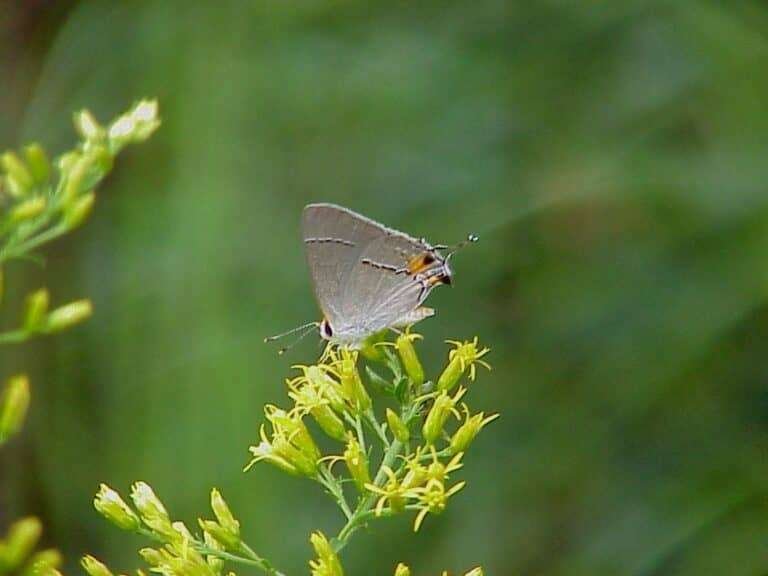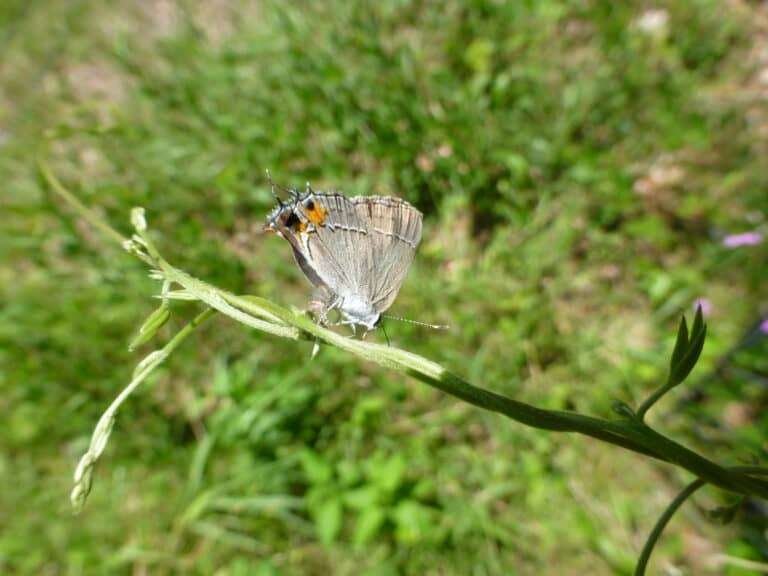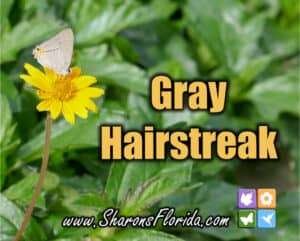
Strymon melinus
(Gray Hairstreak)

Description
Gray hairstreaks are small butterflies which are usually smaller than an inch. They have gray wings with lines of black and white markings along with an orange spot on the hindwing and orange on the back of the head creating an orange collar.
They have black and white striped legs, black and white clubbed antennae and a white face and large black eyes.
The hindwing postmedian line can vary widely sometimes making it hard to identify. The lines on the gray hairstreak are white outwardly and black inwardly. The hindwing also has an orange spot.
Scientific Name, Common Name & Family
The gray hairstreak (Strymon melinus) is also called the bean lycaenid or cotton square borer. It is a member of the Lycaenidae family, known as the gossamer-winged butterflies and the second-largest family of butterflies. [1]

Behavior
The gray hairstreak moves around the garden very quickly from flower to flower and can be hard to get a good look at for long enough to identify.
Sometimes with these small butterflies it takes time and patience to get a positive identification, but it’s well worth it because then you can focus on the host plants for that particular butterfly.
Another good way to identify them is to take photos and enlarge them to compare.
Also check their range maps. If you think it’s a rare species and it’s not shown for your area then it is most likely a more common species.
Their caterpillars are well camouflaged and generally roll up, or fold over, a leaf and stay within it to feed and hide from predators.

Habitat
The gray hairstreak is usually found in open fields, pastures, weedy roadsides, disturbed sites, and flower gardens.
Range
The gray hairstreak is found throughout the state of Florida.
They are found throughout the United States from Canada to Mexico.
Food
Adult gray hairstreaks visit a wide variety of flowers from groundcovers to tree blossoms. The adults fly close to the ground and may go unnoticed unless nectaring or laying eggs. That’s about the only time they seem to sit still for a moment.
The small caterpillars of the gray hairstreak tend to roll up the host plant leaves and make tents or hiding places to avoid predators. The female adult lays eggs on the new growth, and tender new tips, of the host plants.

Nesting and Young
The gray hairstreak uses these native plants as host plants in Central Florida:
Desmodium canescens (hoary ticktrefoil)
Desmodium ciliare (hairy small-leaf ticktrefoil)
Desmodium floridanum (Florida ticktrefoil)
Desmodium glabellum (Dillenius’ ticktrefoil)
Desmodium paniculatum (panicled ticktrefoil)
Desmodium perplexum (perplexed ticktrefoil)
Desmodium strictum (pinebarren ticktrefoil)
Desmodium tenuifolium (slimleaf ticktrefoil)
Desmodium viridiflorum (velvetleaf ticktrefoil)
Galactia elliottii (Elliott’s milkpea)
Galactia floridana (Florida milkpea)
Galactia mollis (soft milkpea)
Galactia purshii (Pursh’s milkpea)
Galactia volubilis (Eastern milkpea)
This list does not include the non-native species of host plants, such as the common beggarweed Desmodium incanum.
The only seed I have currently for sale off of this list is Eastern Milkpea (Galactia volubilis) ✤ 20 Seeds.





